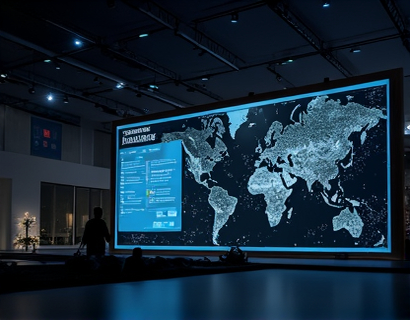Next-Gen QR Code Solutions: Transforming Business Engagement and Social Media Interaction for Modern Brands
In the rapidly evolving digital landscape, businesses and social media managers are constantly seeking innovative ways to enhance engagement and deepen connections with their audience. One such technology that has emerged as a game-changer is the next-generation QR Code, often referred to as enhanced or intelligent QR Codes. These advanced codes go beyond the traditional static barcode, offering customizable and intuitive tools that streamline information sharing and significantly boost customer interaction. This article delves into the transformative potential of next-gen QR Codes, exploring how they are reshaping the way modern brands interact with their audience and manage their digital presence.
The Evolution of QR Codes
QR Codes, or Quick Response Codes, were first developed in the 1990s primarily for use in the automotive industry to track parts during manufacturing. Over the years, they have found widespread use across various sectors, from marketing and advertising to logistics and healthcare. Traditional QR Codes are two-dimensional barcodes that can store a variety of data, including URLs, text, and even binary data. However, their static nature and limited customization options have been a barrier to more sophisticated applications.
The evolution of QR Codes into next-gen versions marks a significant leap forward. These new codes are designed to be more versatile, secure, and user-friendly. They incorporate advanced features such as dynamic content updates, enhanced security protocols, and the ability to integrate with various digital platforms. This evolution has opened up new possibilities for businesses and social media managers looking to create more engaging and interactive experiences for their audience.
Customizable Design Options
One of the most compelling features of next-gen QR Codes is their customizable design. Unlike traditional QR Codes, which have a fixed shape and color scheme, modern QR Codes can be tailored to match a brand's visual identity. This customization extends to shape, color, and even the inclusion of logos or images within the code itself. Such flexibility allows brands to integrate QR Codes seamlessly into their marketing materials, packaging, and digital content without compromising on aesthetics.
For instance, a fashion brand can design a QR Code that matches the color and style of its clothing line, making it a natural part of the product presentation. This not only enhances the visual appeal but also reinforces brand recognition. The ability to customize QR Codes ensures that they align with the overall brand strategy, making them a powerful tool for consistent and cohesive marketing efforts.
Dynamic Content Updates
Another significant advantage of next-gen QR Codes is their dynamic content update capability. Traditional QR Codes once printed are static and cannot be changed without recreating the entire code. In contrast, dynamic QR Codes can be updated in real-time through a centralized management system. This means that businesses can modify the content linked to a QR Code without the need to print new codes, saving time and resources.
For example, a travel company can use a dynamic QR Code to provide flight information. If there are changes in flight schedules or cancellations, the company can update the QR Code instantly, ensuring that customers always have access to the most current information. This level of flexibility is crucial in maintaining customer trust and satisfaction, especially in industries where accuracy and timeliness are paramount.
Enhanced Security Features
Security is a critical concern in today's digital environment, and next-gen QR Codes address this by incorporating advanced security features. These codes can include encryption and authentication mechanisms to protect sensitive information from unauthorized access. For businesses handling confidential data, such as financial institutions or healthcare providers, this added layer of security is invaluable.
Moreover, dynamic QR Codes can be linked to secure servers, ensuring that data transmission is safe and compliant with industry standards. This not only protects the brand's reputation but also builds customer confidence. The ability to secure QR Codes makes them a reliable choice for applications where data integrity is essential.
Integration with Digital Platforms
The true power of next-gen QR Codes lies in their seamless integration with various digital platforms. These codes can be linked to websites, social media profiles, mobile apps, and even IoT devices, creating a cohesive and interconnected digital experience. For businesses, this means they can direct customers to specific online content or actions with a single scan, streamlining the customer journey and enhancing engagement.
For instance, a retail brand can use a QR Code on its product packaging to direct customers to a dedicated landing page with additional product information, customer reviews, and special offers. This not only provides valuable insights but also encourages customers to take further action, such as making a purchase or signing up for a newsletter. The integration with digital platforms ensures that the QR Code serves as a gateway to a richer, more interactive experience.
Boosting Social Media Interaction
Social media platforms are a crucial channel for brand engagement, and next-gen QR Codes can significantly enhance interactions on these platforms. By placing QR Codes in social media posts, businesses can drive traffic to their websites, increase app downloads, or even encourage users to participate in interactive campaigns. The immediacy and convenience of scanning a QR Code make it an effective tool for boosting engagement and fostering community involvement.
For example, a music festival can include a QR Code in its promotional materials that, when scanned, directs users to a landing page with ticket purchasing options, artist bios, and a schedule. This not only simplifies the process for attendees but also provides the festival organizers with valuable data on user interactions and preferences. The ability to track and analyze this data can inform future marketing strategies and improve overall event management.
Personalized Customer Experiences
Next-gen QR Codes enable brands to deliver personalized experiences to their customers. By linking QR Codes to user-specific content, businesses can tailor interactions based on individual preferences and behaviors. This personalization can lead to higher customer satisfaction and loyalty, as users feel that the brand understands and values their unique needs.
Consider a luxury car dealership that uses QR Codes on its showroom floor. Each code can be linked to a personalized webpage that highlights vehicles based on the customer's browsing history and preferences. When a customer scans a QR Code, they are presented with a curated selection of cars that align with their interests, along with detailed specifications and special offers. This level of personalization not only enhances the shopping experience but also increases the likelihood of a sale.
Data Collection and Analysis
One of the most underappreciated benefits of next-gen QR Codes is their ability to collect and analyze data. Each scan generates a record that can be tracked and analyzed to gain insights into customer behavior and preferences. This data can be used to optimize marketing campaigns, improve product offerings, and enhance overall customer service.
For example, a retail brand can use QR Codes to track which products are most frequently scanned, indicating high customer interest. This information can inform inventory management and marketing strategies, ensuring that the brand focuses on its most popular items. Additionally, analyzing scan data can reveal patterns in customer behavior, such as preferred times of day for scanning or locations where QR Codes are most effective. These insights can drive data-driven decision-making, leading to more effective business strategies.
Case Studies: Real-World Applications
To better understand the impact of next-gen QR Codes, let's explore a few real-world applications across different industries.
In the hospitality sector, a hotel chain implemented dynamic QR Codes on its room keys. Guests can scan the code to access their room's digital concierge, which provides information on local attractions, restaurant recommendations, and even allows them to order room service or book spa treatments. This not only enhances the guest experience but also reduces the need for physical materials, aligning with sustainability goals.
In the education sector, a university used QR Codes on its campus maps to provide students and visitors with real-time information on events, facilities, and navigation. By scanning a QR Code on the map, users receive a link to a mobile app that offers an interactive guide, complete with videos and testimonials. This interactive approach not only improves navigation but also enriches the overall campus experience.
In the healthcare industry, a clinic incorporated QR Codes into patient records, allowing patients to access their medical history, appointment schedules, and treatment plans with a simple scan. This not only streamlines the patient experience but also ensures that patients have easy access to important information, promoting better health management.
Challenges and Considerations
While next-gen QR Codes offer numerous benefits, there are also challenges and considerations that businesses should be aware of. One key challenge is ensuring compatibility across different devices and scanning applications. To maximize reach, it's essential to test QR Codes with various smartphones and apps to ensure a smooth scanning experience.
Another consideration is the potential for misuse or unauthorized access to sensitive information. Brands must implement robust security measures, such as encryption and access controls, to protect user data. Additionally, transparency is crucial; users should be informed about what data is being collected and how it will be used to build trust and compliance with privacy regulations.
Finally, while next-gen QR Codes are a powerful tool, they should be part of a broader digital strategy. Integrating QR Codes with other digital channels, such as social media and email marketing, can create a more comprehensive and effective engagement approach. This multi-channel strategy ensures that the QR Code complements and enhances other marketing efforts rather than standing alone.
Conclusion
Next-gen QR Codes represent a significant advancement in digital engagement tools, offering customizable, secure, and integrated solutions that can transform how businesses and brands interact with their audience. By leveraging these advanced codes, brands can create more personalized, interactive, and data-driven experiences that foster deeper connections and enhance overall engagement. As the digital landscape continues to evolve, embracing next-gen QR Codes can be a strategic move for modern brands looking to stay ahead of the curve.










































